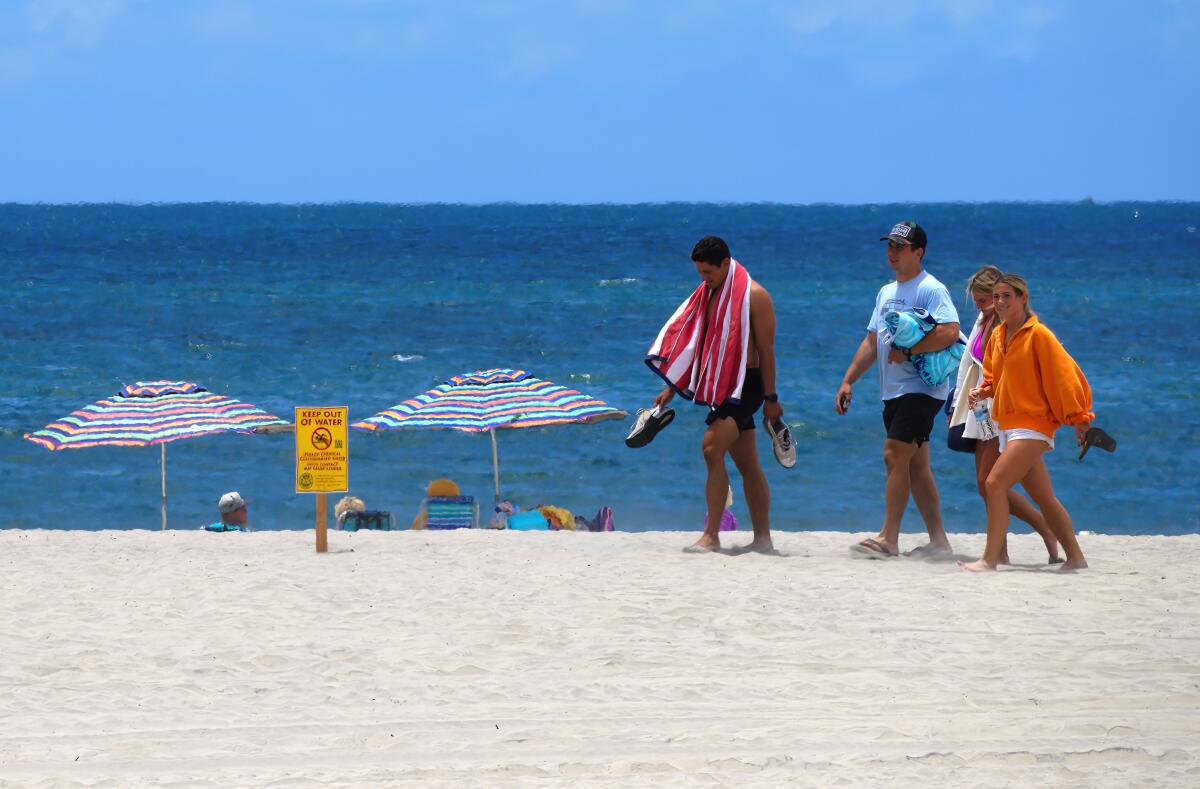How did San Diego’s sewage-blasted shorelines evade the list of dirtiest beaches in California?

SAN DIEGO — Heal the Bay released its 33rd annual beach report card this week, including a list of the dirtiest shorelines in California.
Glaringly absent were the ocean waters off San Diego’s southern coast, from Coronado down to Imperial Beach. Residents there have endured a record number of swimming restrictions over the last 18 months as massive amounts of sewage continue to spill over the border from Tijuana.
This story is for subscribers
We offer subscribers exclusive access to our best journalism.
Thank you for your support.
The issue is so bad that the federal government has ponied up $300 million to expand a wastewater facility in San Diego that treats sewage from Mexico. Mayors across the region just this week signed a letter urging President Biden to declare a state of emergency over the rampant pollution.
So why didn’t the Santa Monica-based nonprofit call out these San Diego beaches in its latest assessment of the state’s ocean water quality?
The short answer: Advocates with Heal the Bay were somewhat perplexed by a new highly sensitive DNA-based test for water quality launched last year by San Diego County.
“When we plugged in the data, those San Diego beaches, they all failed,” said Luke Ginger, water quality scientist at Heal the Bay. “Our beach bummer list would have just been San Diego County beaches.”
Rather than embrace the DNA-based results, Heal the Bay decided to rely on the traditional culture-based method in which scientists examine samples of ocean water for bacterial growth in a lab. The approach is used by nearly all jurisdictions in California.
The differences in the side-by-side testing were stark. For example, Imperial Beach’s southern coast failed water quality testing 85% of the time last summer using the DNA-based method, compared to just 20% with traditional testing.
“We’re not saying the new method is bad in any way. In fact, it’s the cutting-edge technology,” Ginger said. “The unknown is the actual public health risk. What we need now is to pair this with an epidemiological study.”
The county was quick to defend its new approach, which was developed over the last decade with help from the California Department of Public Health and U.S. Environmental Protection Agency.
“We are surprised that in its recent report card Heal the Bay would call for a lesser water-testing method considering its stated mission is to make coastal waters and watersheds safe, healthy and clean,” the county Department of Environmental Health and Quality said in an email.
“Changing a number or method won’t change the sewage contamination problem our community is experiencing year-round or the number of water-contact closures,” the agency added.
Not everyone in San Diego shares that sentiment. Some local leaders and at least one scientist have questioned whether the threshold for what constitutes unsafe swimming conditions with the DNA-based approach is appropriate.
San Diego is the only place in the nation to adopt such technology for monitoring coastal water quality. The process included a peer-reviewed study — co-authored by the county, state health officials, the Southern California Coastal Water Research Project and UC San Diego — to develop a benchmark for acceptable water quality that mirrored the traditional culture-based method.
When San Diego rolled out the DNA-based approach last spring, however, it became clear the two tests were returning very different results.
Coronado Mayor Richard Bailey said he appreciated Heal the Bay’s recent report, which included an entire section on San Diego’s new testing regime. He has frequently called on county officials to consider re-calibrating the threshold for what constitutes a bacterial exceedance under the new test.
“The city of Coronado shares concerns expressed in the report,” he said. “Access to the coastline is important for our region, and we need to make sure the results are accurate.”
So far, there has been no appetite at the county to even discuss the idea that the new testing protocol could be overly sensitive.
“Our local families and residents have been advocating for decades to truly know what is in the water on their beaches,” said County Supervisor Nora Vargas. “They deserve that information, and we have a responsibility to ensure they are given an accurate picture of what that really is.”
Meanwhile, ongoing swimming restrictions are taking a toll on businesses and residents. Coronado has seen its shorelines shuttered for weeks on end, including over Memorial Day weekend, and Imperial Beach has been closed since December.
Imperial Beach also recently canceled its Junior Lifeguard Program for this summer, and YMCA’s Camp Surf just north of the city is preparing to bus kids to La Jolla and Pacific Beach.
“We didn’t want to give all these beaches an F and call it a day. That didn’t feel right,” said Ginger with Heal the Bay. “There needs to be some sort of re-evaluation of that threshold, I think.”
Santa Monica Pier and Playa Blanca in Tijuana have the dirtiest summertime beaches, according to Heal the Bay’s 2023 survey. Those locations were followed by several shorelines in San Mateo County, including Marlin Park, Erckenbrack Park and Linda Mar Beach.
The sixth most polluted waterway in the report was the mouth of the Tijuana River on the San Diego border with Mexico.
More to Read
Sign up for Essential California
The most important California stories and recommendations in your inbox every morning.
You may occasionally receive promotional content from the Los Angeles Times.











